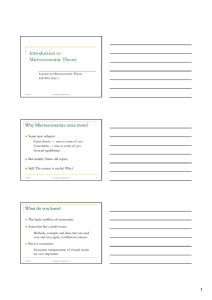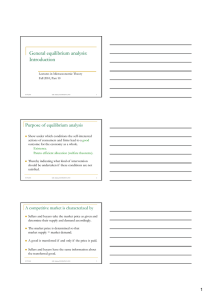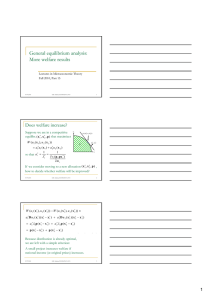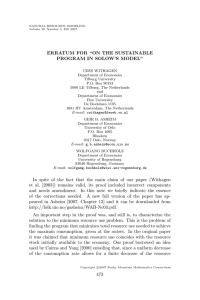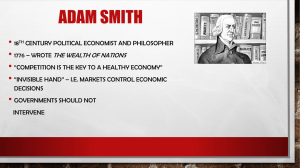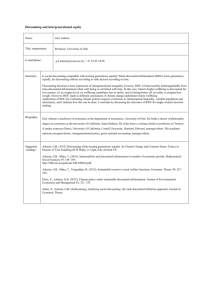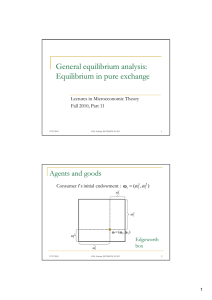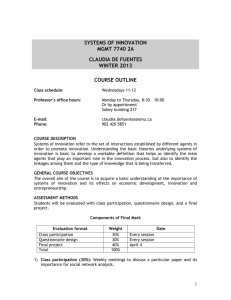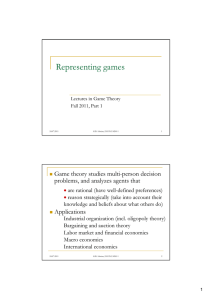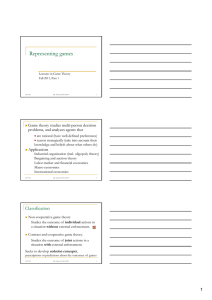Introduction to Microeconomic Theory Why Microeconomics once more? Some new subjects
advertisement
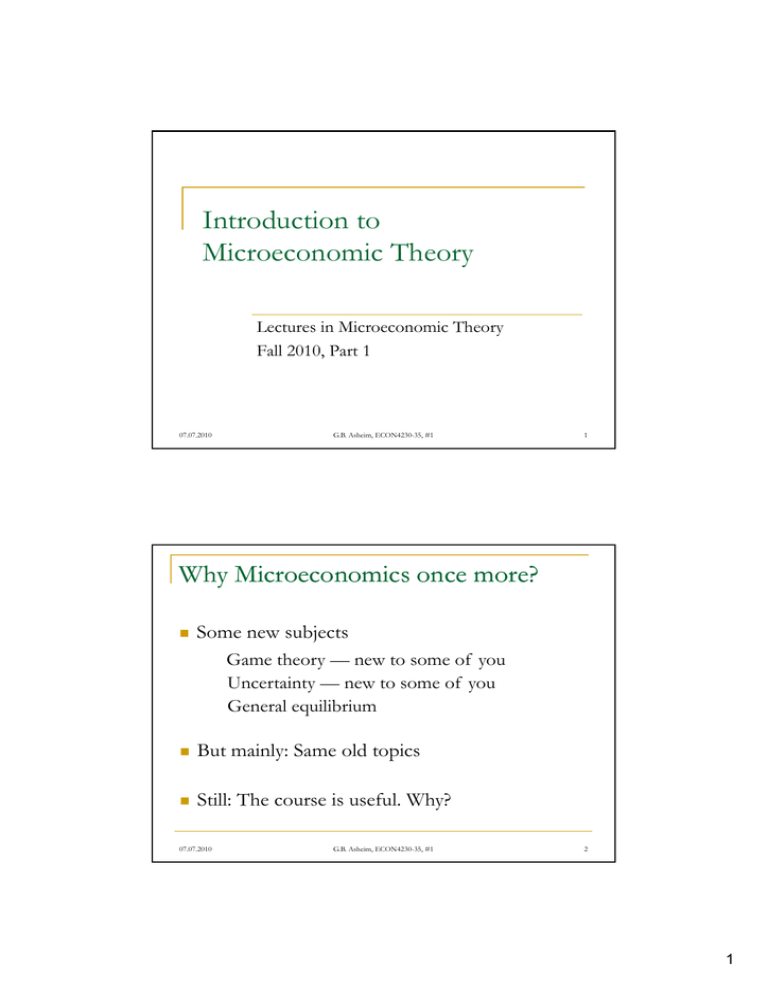
Introduction to Microeconomic Theory Lectures in Microeconomic Theory Fall 2010, Part 1 07.07.2010 G.B. Asheim, ECON4230-35, #1 1 Why Microeconomics once more? Some new subjects Game theory — new to some of you Uncertainty — new to some of you General equilibrium But ut mainly: a y: Same Sa e old o d topics top cs Still: The course is useful. Why? 07.07.2010 G.B. Asheim, ECON4230-35, #1 2 1 What do you learn? The basic toolbox of economics Somewhat like a math course Methods, concepts and ideas that are used over and over again, in different contexts B t it is But i economics i Economic interpretation of formal results are very important 07.07.2010 G.B. Asheim, ECON4230-35, #1 3 Few applications You will find the applications in other courses The new concepts are abstract But, as always: Expect to put in lot of your own effort if you want to benefit from the course 07.07.2010 G.B. Asheim, ECON4230-35, #1 4 2 What is Microeconomic Theory? Begins by considering the behavior of individual actors t andd builds b ild from f this thi foundation f d ti to t a theory th of aggregate economic outcomes Theory of the firm Consumer theory Equilibrium analysis (partial and general) 07.07.2010 G.B. Asheim, ECON4230-35, #1 5 What is in the toolbox? Principles of microeconomics: Standard analytical procedure and fairly simple theorems that can be applied again and again to apparently dissimilar economic problems. Duality theory Abstract modeling of economic interaction: Economic actors Firms and consumers Motivation Profit & utility max. Economic environment Perfect competition 07.07.2010 G.B. Asheim, ECON4230-35, #1 6 3 Specific goals of microeconomic analysis Show under which conditions the self-interested actions ti off consumers andd firms fi lead l d to t a goodd outcome for the economy as a whole. Existence. Pareto efficient allocation (welfare theorems). Thereby Th b iindicating di i what h ki kind d off iintervention i should be undertaken if these conditions are not satisfied. 07.07.2010 G.B. Asheim, ECON4230-35, #1 7 A competitive market is characterized by Sellers and buyers take the market price as given and determine their supply and demand accordingly. The market price is determined so that market supply = market demand. A good is transferred if and only if the price is paid. Sellers and buyers have the same information about the transferred good. 07.07.2010 G.B. Asheim, ECON4230-35, #1 8 4 Pure exchange All economic agents are consumers. ConsumpConsump tion goods Consumer 1 Consumer 2 Payments Given the market prices and initial endowment of consumption n mpti n goods, d consumers n m r choose h th the b bestt vector of consumption goods, given that positive net demand of some goods must be financed by positive net supply of other goods. 07.07.2010 9 G.B. Asheim, ECON4230-35, #1 With production Some economic agents are consumers, other agents are firms. Consumption goods and payments Consumers Profits Firms Labor (and capital) and Given the market Given the market prices, each consumer wages (and interest) prices and the chooses a best combination of technological constraints constraints, each firm chooses a labor supply and consumption combination of consumption good demand, given that he good supply and factor demand must pay for the consumption that maximizes profits. goods with his labor income. 07.07.2010 G.B. Asheim, ECON4230-35, #1 10 5 Rôle for intervention Prevent that firms get market power ― competition policy A competitive market is characterized by Sellers and buyers take the market price as given and determine their supply and demand accordingly. The market price is determined so that market supply = market demand. A good is transferred if and only if the price is paid. Sellers and buyers have the same information about the transferred good. Ensure that markets clear ― labor market policy Protect private property, create low transaction costs Ensure that firms pay for external effects (pollution) Ensure efficient provision of public goods Address informational problems Contribute to a just income distribution 07.07.2010 Fields of microeconomics 11 G.B. Asheim, ECON4230-35, #1 Industrialthat Prevent organization firms get market power ― (Game theory) competition policy A competitive market is characterized by Sellers and buyers take the market price as given and determine their supply and demand accordingly. The market price is determined so that market supply = market demand. A good is transferred if and only if the price is paid. Sellers and buyers have the same information about the transferred good. Ensuremarket Labor that markets economics clear ― labor market policy Protect private Economics of crime, property, transaction create low costs transaction economics costs Ensure that firms Environmental economics pay for external effects (pollution) Ensureeconomics Public efficient provision of public goods Address informational Information economicsproblems (Game theory) Contribute to a just public incomefinance distribution Welfare economics, 07.07.2010 G.B. Asheim, ECON4230-35, #1 12 6
